“When Johnny comes marching home again
Hurrah! Hurrah!
We’ll give him a hearty welcome then
Hurrah! Hurrah!
The men will cheer and the boys will shout
The ladies they will all turn out
And we’ll all feel gay
When Johnny comes marching home.”
One hundred eleven years ago, a handsome 19-year-old sailor named Homer Baker with medium brown hair and blue eyes, just under 5’10” and weighing 158 and a half pounds, sailed into San Francisco harbor aboard the U.S.S. New Jersey where he’d been a messenger.
Related: Why this gay Navy kiss just made history
The New Jersey was part of an armada including 16 battleships and 14,000 sailors that made up President Teddy Roosevelt’s Great White Fleet, on a 14-month, 43,000 nautical mile voyage around the world to demonstrate American military might.
Never Miss a Beat
Subscribe to our newsletter to stay ahead of the latest LGBTQ+ political news and insights.
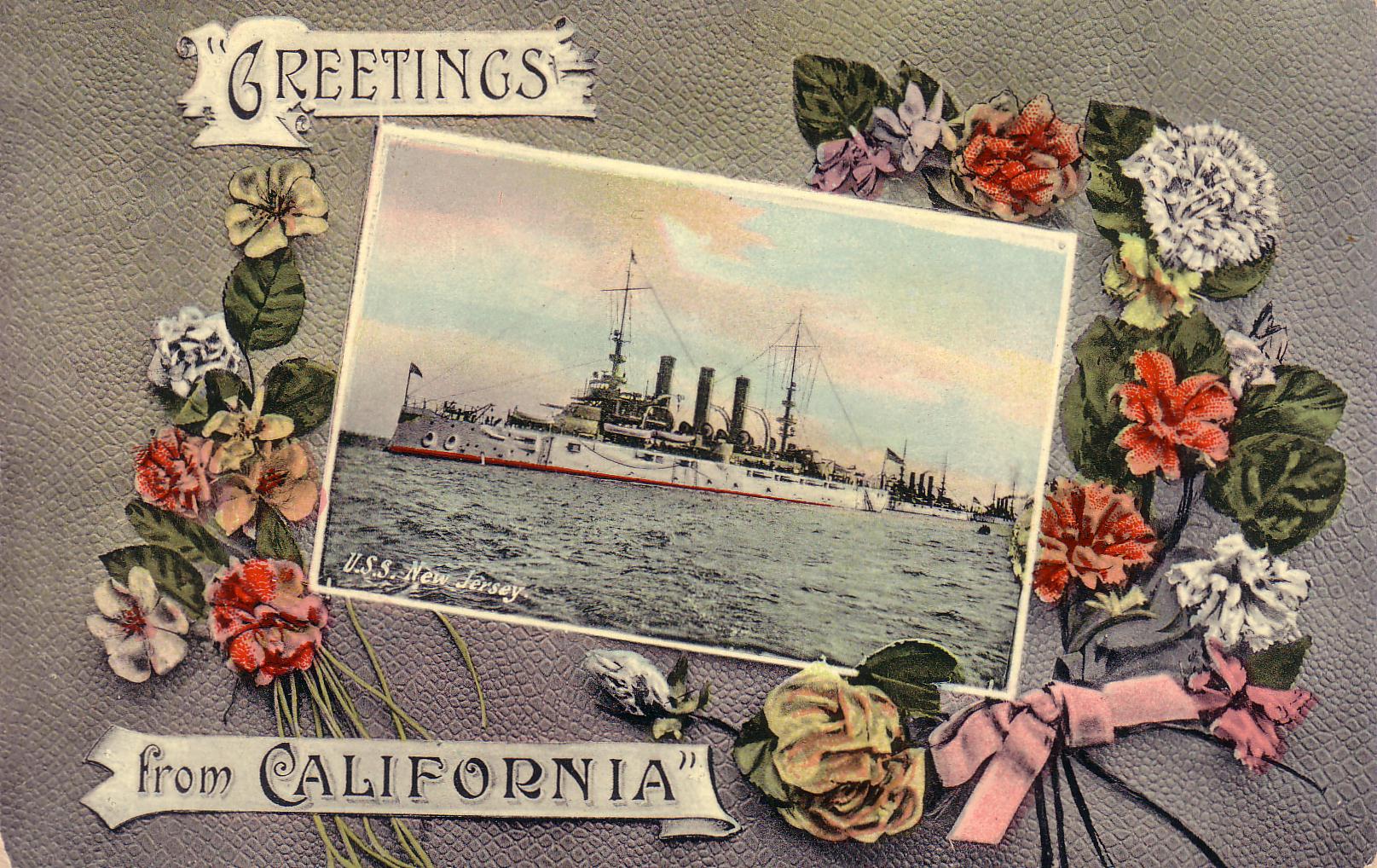
Their arrival in every port was an event of unprecedented proportions and excitement, especially for San Francisco still recovering from the 1906 earthquake. The ruins that remained everywhere were briefly brightened by a blaze of red, white, and blue pennants proclaiming, WELCOME OUR FLEET; countless kinds of souvenirs sold briskly, and a huge patriotic parade of thousands of sailors and Marines, local and national dignitaries, and brass bands passed beneath a forest of giant American flags along Market Street to Van Ness Avenue to Washington Street and back again.
“The old church bell will peal with joy
Hurrah! Hurrah!
To welcome home our darling boy,
Hurrah! Hurrah!
The village lads and lassies say
With roses they will strew the way,
And we’ll all feel gay
When Johnny comes marching home.”
But for Baker and another sailor, 24-year-old Thomas Keene, the party was soon over. They were charged with and found guilty of sodomy and turned over to local police. Baker was sentenced to six years and Keene to ten years in California’s infamous San Quentin prison. The Navy had no maximum security facility on the west coast and paid a fee to the state for housing any felons for them.
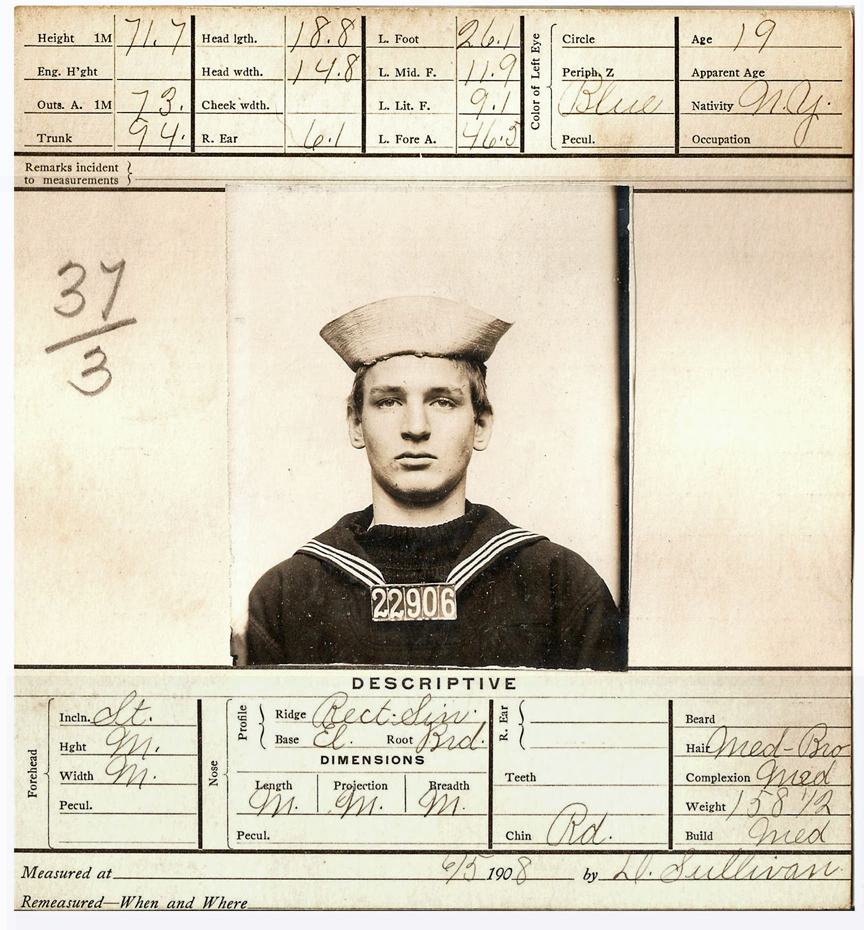
“Get ready for the Jubilee,
Hurrah! Hurrah!
We’ll give the hero three times three,
Hurrah! Hurrah!
The laurel wreath is ready now
To place upon his loyal brow
And we’ll all feel gay
When Johnny comes marching home.”
The look in Baker’s 19-year-old eyes in his booking photo reflects all of the shock, the sadness, the despair that one can imagine every one of the tens of thousands of other sailors felt over the decades when they, too, were caught in the Navy’s net of homophobia which was more vicious and unforgiving than any of the other branches.
“Let love and friendship on that day,
Hurrah, hurrah!
Their choicest pleasures then display,
Hurrah, hurrah!
And let each one perform some part,
To fill with joy the warrior’s heart,
And we’ll all feel gay
When Johnny comes marching home”
How would he tell, what would he tell his father and mother, Ellis and Clara Baker, and his little brother Dorr back in New York about why they wouldn’t be getting any more postcards from him from around the world while his comrades sailed on as America’s newest heroes?
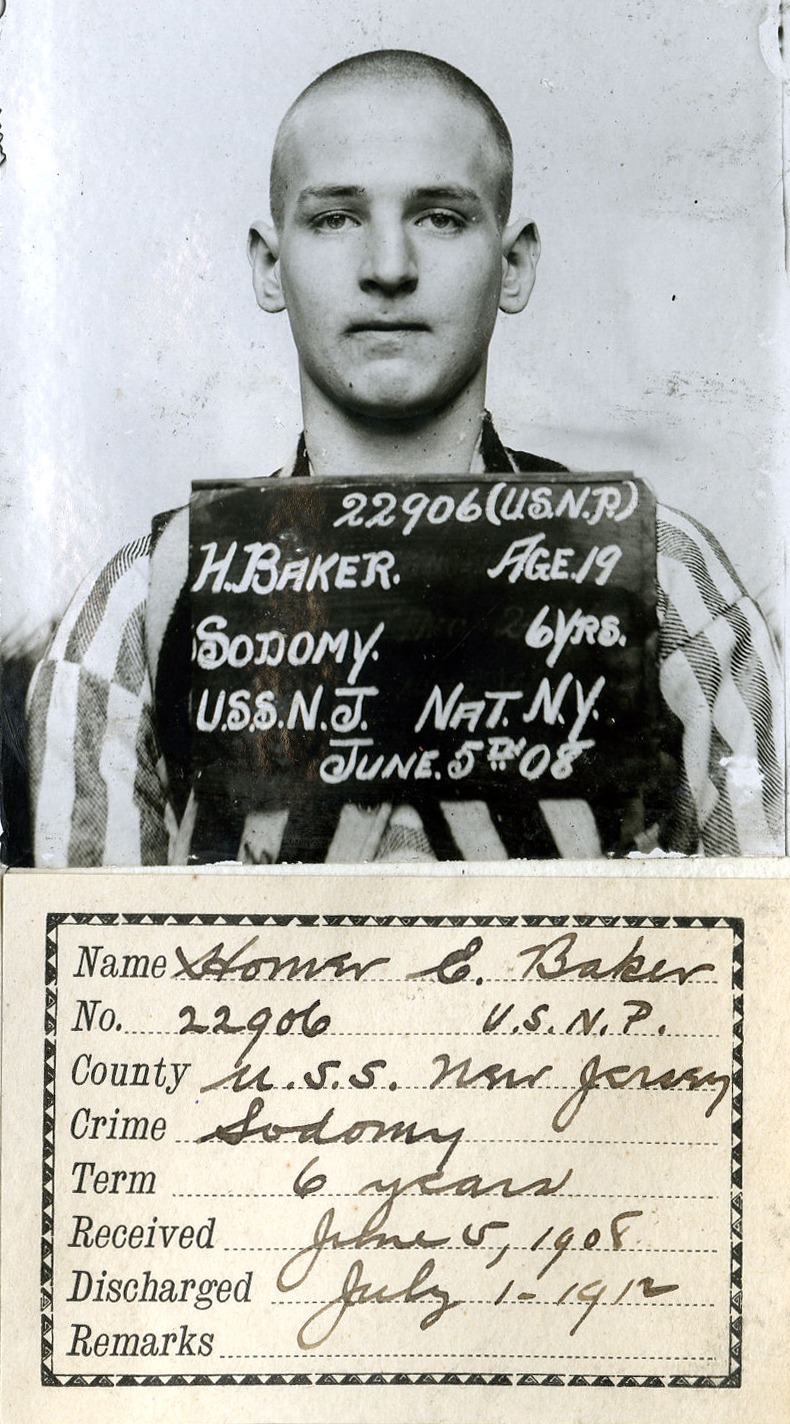
The second photo, taken at San Quentin after his head had been shaved and his sailor suit surrendered for prison stripes, seems to reflect an attempt to hide the fear he must have felt about what his life would be like behind those bars even if the other inmates didn’t find out why he was there.
Baker became a concrete worker in the prison construction department where Keene worked as a carpenter. Receiving some grace, both served less time than their sentences; Baker four years and Keene six years, five months.
Deepest thanks to San Francisco historian Bill Lipsky for sharing his remarkable research and photos.
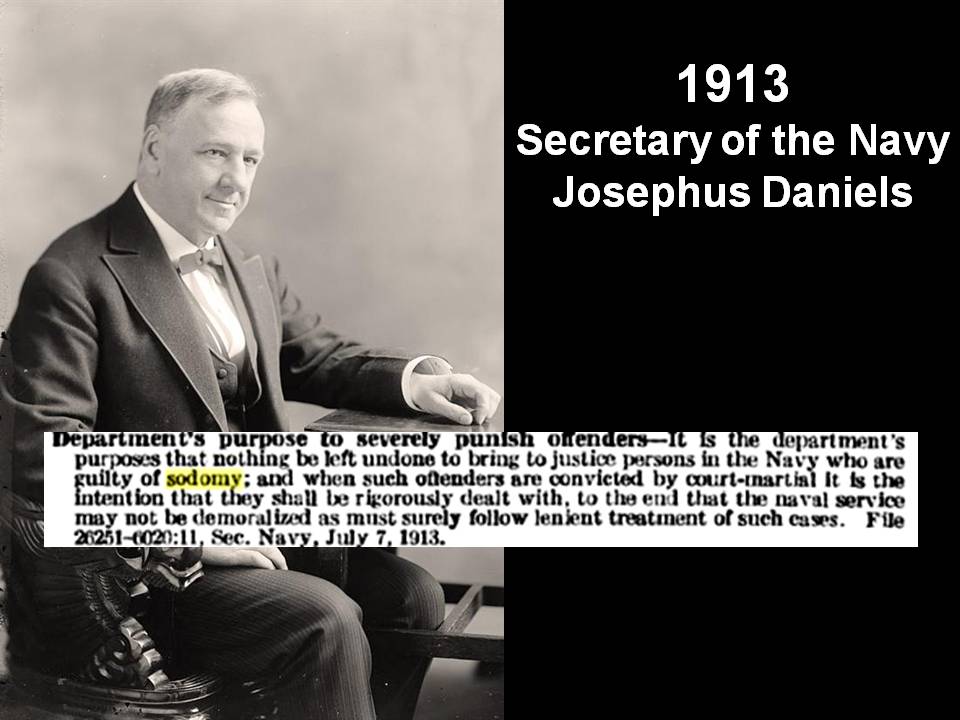
1916. “Recommended, ‘That the commandants and commanding officers of the naval training stations be instructed to cause lectures or talks to be give to apprentices under training, setting forth the nature of such offenses [sodomy, sexual perversion, etc.], the liability of all parties concerned, and the fact that the department insists upon severe punishment being meted out in all cases.” – Judge Advocate General of the Navy.
1919. As documented by Lawrence Murphy in Perverts by Official Order: The Campaign Against Homosexuals by the United States Navy, 1988, the Navy’s first of several infamous witch-hunts began at the Newport, Rhode Island, Naval Training Station, though started entirely on his own initiative by pathologically anti-gay Machinist’s Mate Ervin Arnold.
Having transferred from San Francisco, he’d been told to anticipate an active sailor-civilian gay underground in Newport. Within a month of arriving he had already found it with his gift for getting gay sailors (and civilians) to share the most intimate details with him about their own and others’ sex lives (which he later wrote down for future reference).
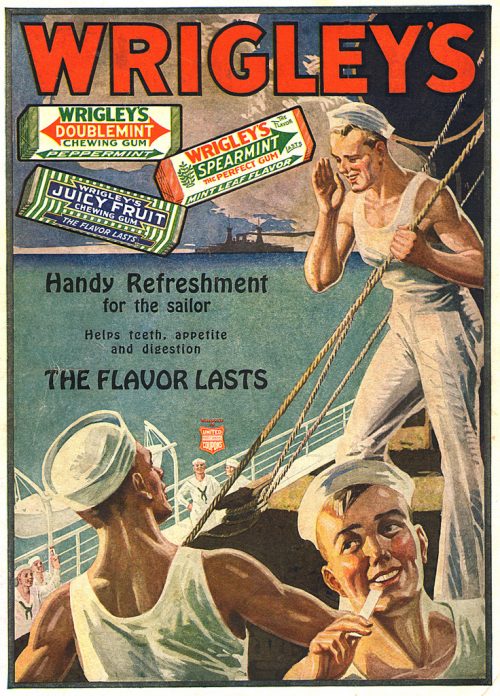
Soon he was recruiting sailor “operatives” to spy on other sailors and suspected civilian gays at the Army/Navy YMCA, private residences, and local cruising spots, convincing some to have sex with them if they believed it necessary to entrap them. He used at least 41 ostensibly straight sailors (though all weren’t), some as young as 16, for the months-long “investigation.”
Apparently it was a statute left over from World War I that enabled the Navy to go after civilians for homosexual acts such as the witch-hunt’s eventual primary civilian target, Episcopal priest Samuel Neal Kent, extremely popular for his work as a chaplain at the base hospital during the huge 1918 influenza epidemic.
It prohibited anyone within ten miles of a military installation of receiving someone “for the purpose of lewdness, assignation or prostitution into any vehicle, conveyance, place, structure or building.” They chased Kent across more than one state, but he was found innocent at two trials after forcefully denying sometimes inconsistent accusations by more than one sailor that he had forced sex upon them in his house, car, and on a boat.
Needing money to support his campaign and some kind of official imprimatur with which to recruit more “operatives,” Arnold went to a base doctor who, as an officer, was able to involve more and more higher ups, leading to the involvement of Assistant Secretary of the Navy Franklin Roosevelt.
The result was not only the ruining of several lives and prison sentences for some but a United States Senate investigation that condemned all involved, including Roosevelt for causing “innocent” young sailors to engage in perversion to entrap others. Note the Senate was not defending the actual “perverts.” Roosevelt continued to insist that he had had no knowledge that such tactics were used, and, as I’ve previously written, I believe him.
He certainly wasn’t without some blame for not asking for explicit details of their “investigation” methods, but the sofa was already engulfed in flames when he sat down on it, and he wasn’t to learn until it was too late just how hot the fire was.
The fire wasn’t put out until Kent’s allies both in the church and the press publicly blew wide open the witch-hunt.
Like all the branches, the Navy significantly relaxed its ban on gays during WWII in order to maximize the troop strength required. But one still needed to be careful. Sarah Davis from tiny Independence, Iowa, whose nickname was “Sammi,” joined in the Navy WAVES (Women Accepted for Volunteer Emergency Service) in 1943 for “the adventure, the excitement. I was going to save the world for democracy. I liked the military life. I liked the discipline. I liked the order. I liked the marching, and the tunes.”
Though WAVES could not serve aboard combat ships or aircraft, they supported them; Davis was an Aviation Machinist Mate First Class at the Naval Air Station in Vero Beach, Florida, and wrote news stories for the Naval Flight Exhibition Team in Jacksonville.
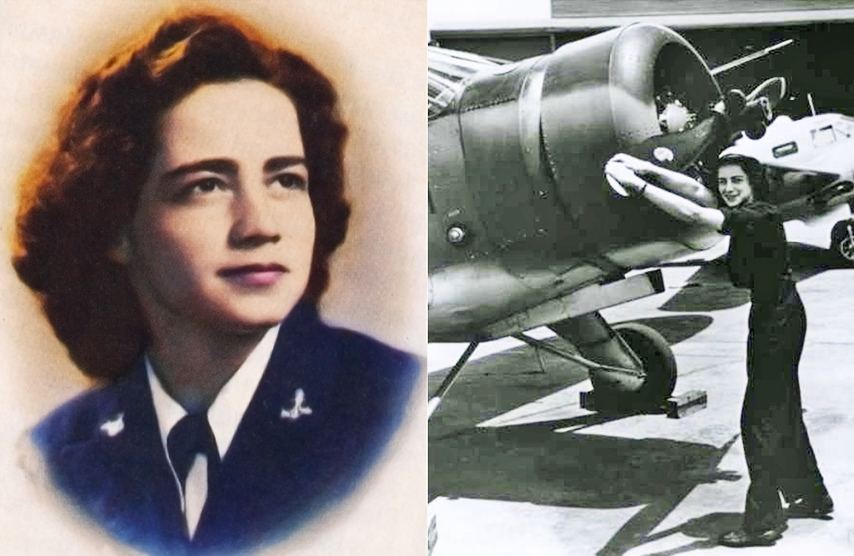
Before serving, she remembered she hadn’t heard “anything about being queer. Didn’t even know that word existed when I went into the Navy. We used to go to the bars open to lesbians, and hug and kiss and so on, but we had to keep things under control. And we definitely couldn’t acknowledge commanding officers who might be lesbian, because you could get into big trouble. You had to form relationships very discreetly and privately.”
After the war, she was interrogated during a witch-hunt, a part of the about-face the military did once they no longer needed so many troops after mostly “looking the other way” for four years. She survived by breaking up with her lover, and denying she knew other gay women, and was ultimately given an honorable discharge. But she told documentary filmmaker Arthur Dong that, “[I]t made me very, very guarded for years and years. It took away what power that I thought I had. It broke my spirit, really, a lot. And that’s been hard to recover, very hard.”
The Navy had become the most ruthless branch once again; and the kind of lectures the Navy Judge Advocate General had promoted in 1916 became more formalized.
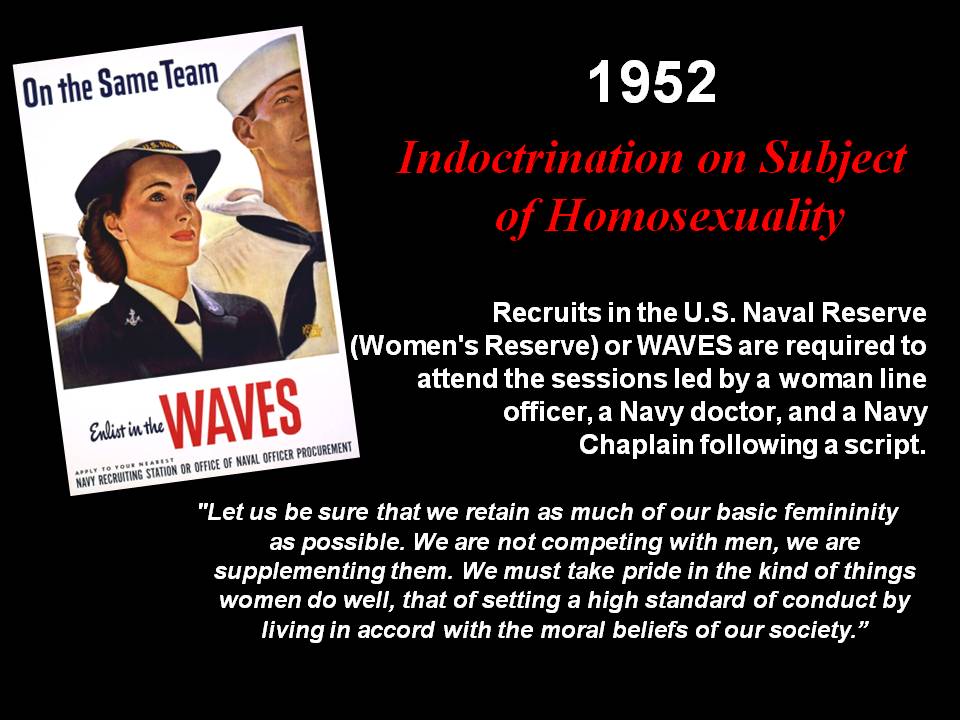


During this time the Office of Naval Intelligence and Naval Investigative Service (NIS) became infamous for their particularly extreme homophobia.
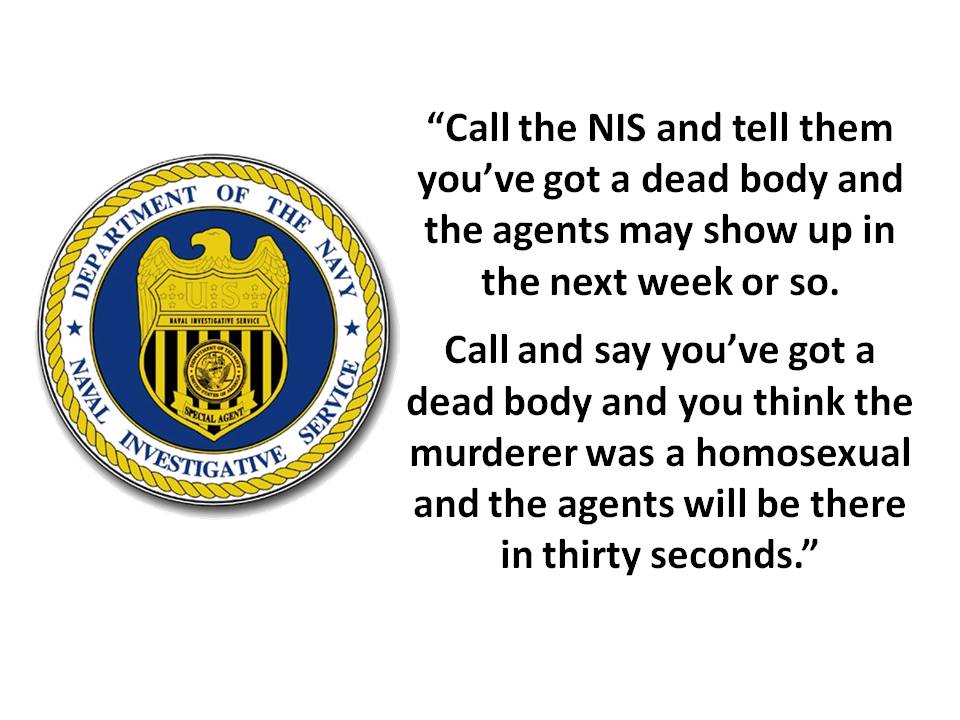 They used the same tactic all the branches did. Pressure one suspected gay person to name others; promising more lenient treatment, maybe even retention, if they do, and more severe punishment and humiliation such as contacting their parents if they don’t.
They used the same tactic all the branches did. Pressure one suspected gay person to name others; promising more lenient treatment, maybe even retention, if they do, and more severe punishment and humiliation such as contacting their parents if they don’t.
For his landmark study, Conduct Unbecoming, Randy Shilts found that between 1986 and 1990, 3663 investigations resulted in 5951 discharges.
1957. US Naval Academy graduate, WWII veteran of naval battles, and retired Rear Admiral Selden Hooper’s medals included a Silver Star and two Bronze Stars.
But years after his retirement, his name was given during such an interrogation, and after utilizing at least “four agents of the Office of Naval Intelligence, two of them commissioned officers, [who] established a stakeout on the roof of a neighboring house, whence they could observe, with the aid of binoculars, the goings on in the Admiral’s bedroom,” he was court-martialed for and found guilty of sodomy, conduct of a nature to bring discredit upon the Armed Forces, and conduct unbecoming an officer and a gentleman.
He was publicly humiliated and, despite six years of legal appeals, was stripped of his rank, pension, and other retirement benefits.
The same year the Navy went after Hooper, they commissioned a study called The Crittenden Report. While not recommending an end to the ban, it did recommend a less harsh policy after concluding that, contrary to the anti-Communist hysteria during the Red and Lavender Scares, gay service members didn’t pose a greater security risk than heterosexual personnel, that many had served honorably without being detected, and that “the concept of homosexuality as a clinical entity has been discarded.”
Yet it was kept secret by the Navy for nearly 20 years until published in the autobiography of Copy Berg.
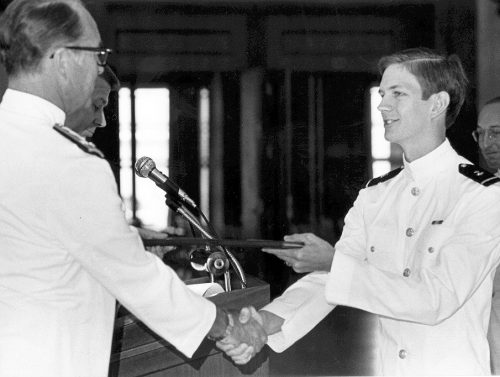
After spying on the outstanding Annapolis graduate and Navy ensign for months the previous year and coercing at least one sailor to falsely testify that he had performed sex on him against his will, the Navy kicked Berg out in 1976 with a less than honorable discharge. On his last day, he’s ordered by Lieutenant Commander C. W. Albaugh to rip the base access sticker off of his car’s bumper in pouring rain.
“The ordeal delivered the desired humiliation. By the time he had returned the pulpy remains of a parking sticker to Albaugh and was ready to leave the base for the last time, Copy was soaked, his dress white uniform splattered with mud.” – Conduct Unbecoming.
As more women were being allowed into the military and into jobs previously limited to men, sexism allied with homophobia to make their lives more difficult than ever. Between 1980 and 1990, women made up 11% of the active Navy force but were 22% of those discharged for being gay; and Black women were disproportionately more kicked out than white women or men and Black men.
In 1980, months after 61 women were the first to be allowed to serve on the USS Norton Sound, 23 were being accused of being lesbians in a typically ruthless and vulgar investigation, including eight of the nine African-American women. Eventually reduced to eight under an unprecedented spotlight from mainstream media, the two that were kicked out before the witch-hunt was suddenly stopped were Black.
1981. Proof that pure stupidity plays a role in bigotry was demonstrated during Mel Dahl’s attempt to fight his discharge, one of at least 1976 sailors kicked out that year – some 800 more than all service members discharged during the worse year of DADT. As related in Conduct Unbecoming:
Dahl told a newspaper reporter that there were many gays serving at the base, which spurred the Navy to launch a purge of what they presumed to be a massive network of homosexuals at Great Lakes. In the course of their investigation, NIS agents made a startling discovery – that homosexuals sometimes referred to themselves as “friends of Dorothy.” This code term had originated in the 1940s and 1950s and referred to Judy Garland’s character in the film The Wizard of Oz. Ever since, gay men had identified themselves as “friends of Dorothy.”
The NIS, however, didn’t know the phrase’s history and so believed that a woman named Dorothy was the hub of an enormous ring of military homosexuals in the Chicago area. The NIS prepared to hunt Dorothy down and convince her to give them the names of homosexuals. In gay bars known to attract military personnel, Dahl learned that NIS agents were asking pointed questions about someone named Dorothy. When one unfortunate sailor acknowledged he was gay in order to get out of the Navy, NIS agents sat him down and told him that they knew all about Dorothy. What they wanted to know from him was how to find her. The sailor, who was too young to know the code, was baffled.
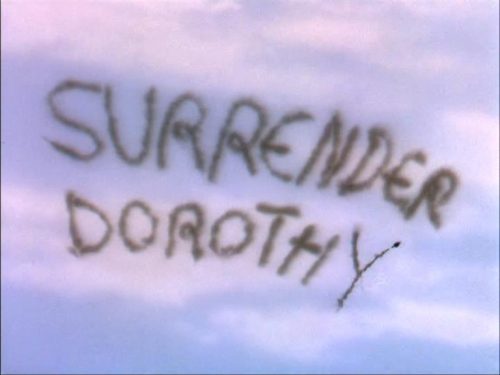
1987. Joe Steffan is kicked out simply for admitting he was gay just weeks before Annapolis graduation. Though in Top 10 of his class, having twice represented the Navy singing “The National Anthem” before televised Army-Navy Games, and being a Battalion Commander over one-sixth of the Academy’s 4500 midshipmen, one superior needlessly attempted to humiliate him by ordering him to literally rip his Commander stripes from his uniform minutes before one of his hearings and later demanded he return his class ring.
Both pre & post-Don’t Ask, Don’t Tell courts ignored the injustice and rationalized his discharge, including one judge who referred to him as a “homo.”
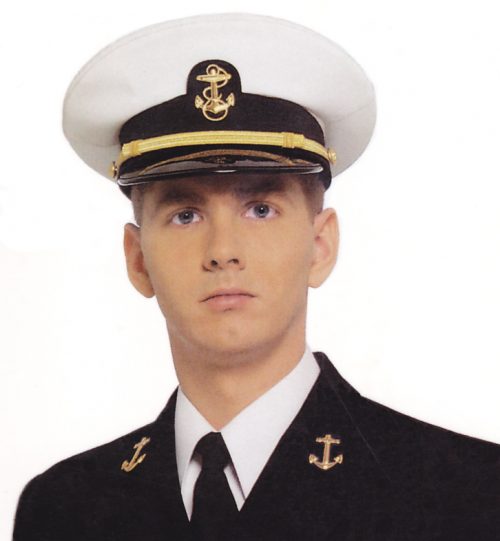
These few examples fail to even touch the surface of the Navy’s decades of ignominy. In the 15 years between 1950 and 1965, the Navy alone kicked out at least 17,392 – nearly 400 more than all the other branches combined did during the entire 17 years that Don’t Ask, Don’t Tell was law.
1989. Congressman Gerry Studds and Congresswoman Patricia Schroeder release to the public the PERSEREC studies that the Navy had denied existed because the researchers found that “studies of homosexual veterans make clear that having a same-gender or an opposite-gender orientation is unrelated to job performance in the same way as is being left- or right-handed” and concluded that gays display “preservice suitability-related adjustment that is as good or better than the average heterosexual.”
My final two stories illustrate the shameful ultimate harvest of the Navy’s decades of toxic homophobia before the repeal of the ban in 2011 took the power away from the idiots and the pathologically bigoted.
In 1989, after a 16-inch gun turret on the U.S.S. Iowa exploded killing 47 crewmen, NIS leaked to the press that they believed the explosion had been related to a love triangle between two sailors, Clayton Hartwig, killed in the blast, and Kendall Truitt and Truitt’s wife. Hartwig’s life insurance policy named Truitt as his beneficiary. In separate interviews with Truitt and his wife, the NIS kept trying to get them to admit that the two men had been lovers and asked Truitt’s wife if she’d ever had a three-way with them, if she and her husband had rough sex, and if she’d been to bed with any of the other crewmembers?
The Washington Post reported, “The NIS probe is pursuing at least two angles: that Truitt may have triggered the explosion to claim the insurance money, and that Hartwig, despondent over a rift in their relationship, caused the blast in an attempt to kill himself and/or Truitt….The NIS is investigating the possibility that Truitt may have tampered with one of the powder bags sent to the gun house where Hartwig normally worked.”
Later NIS decided that Hartwig alone was responsible as a suicidal, mentally deranged homosexual, and his parents were sometimes publicly accosted by strangers, one saying, “Your son
is the gay guy who blew himself up on the ship.”
After long hours of interrogation by NIS, a crew member said Hartwig and sexually propositioned him, shown him an explosive device, and had threatened to blow up Turret Two. Three days later he recanted but NIS kept leaking his original claims to the media without telling them he’d recanted.
The CBS-TV program 60 Minutes exposed the unethical tactics by the NIS and the Navy’s insistence despite evidence to the contrary that the explosion was an act of sabotage by a gay man. For his continued public defense of Hartwig’s innocence, Truitt was denied permission to reenlist and left the Navy.
Congress held hearings criticizing both the NIS and the Navy. The conclusion was that such an accidental explosion was possible and that the Navy’s denials and demonization of Hartwig were driven by a fear that the ship would be retired which finally happened. Shilts: “Navy Secretary Lawrence Garrett III suspended all live firings from the big guns on all of the battleships. As a Navy officer had said six months earlier, the fate of the battleships rose and fell on the Hartwig story and now it had fallen. The battleship guns would be silent forever.”
Seventeen months and millions of dollars in investigation expenses after it began the Navy had exonerated Hartwig and apologized to his family.
In October 1992, 22-year-old sailor Allen Schindler was viciously, brutally beaten to death by two shipmates for being gay. As The New York Times reported:
“I am finally going to a special place,” radioman Allen Schindler wrote on the first page of a pale green notebook he bought two years after entering the Navy. The special place was the aircraft carrier Midway – “the mighty, mighty Midway,” he called it – and the notebook was to be a record of his happiness on board.
Evidently he expected an abiding happiness, for he numbered the bottoms of the pages from 1 to 192. But in 1991 he was transferred to the Belleau Wood, a smaller ship with a reputation for mayhem. As his progressively less legible entries attest, Allen was miserable.
At Christmas [his mother] Dorothy saw he had removed stitches from the logo on his cap, turning the B in Belleau into an H. What she didn’t know was that the hell he was suffering was the hell of a gay man in fear for his life. Allen Schindler loved the Navy and died of unrequited love; it shipped him back, an anonymous pulp, unrecognizable even to his mother, except for the insignia tattooed on his right arm – of the U.S.S. Midway.
Thanks to Box Turtle Bulletin’s Jim Burroway for his excellent summary:
By the time his fellow sailors got done with him, the only identifiable feature left intact was a tattoo on his arm. While on shore leave in Sasebo, Japan, two drunken shipmates followed Schindler into a public restroom in a park. Airman Charles Vins watched – and occasionally joined in – as Airman Apprentice Terry Helvey kneed Schindler in the arm, punched him repeatedly on the floor, and stomped on him with the heel of his boot.
The pathologist described Schindler’s body as the worst case he had ever seen, and compared the damage to that of a “high-speed auto accident or a low-speed aircraft accident.” He also said that it was worse than another case he had seen, that of a man who had been trampled to death by a horse. The pathologist’s report chronicled a litany of lacerations, contusions and abrasions of the forehead, eyes, nose, lips, chin, neck, Adam’s apple, trachea, lungs, liver (which was “like a smushed tomato”) and, tellingly, penis. All but two ribs were broken, and both his lungs and brain had hemorrhaged.
The Navy stonewalled the investigation. The murder occurred just as the pre-DADT debate was getting started over allowing gays to serve in the military. The Navy refused to confirm how Schindler died or whether a weapon was involved. At one point, a Navy senior officer leaked the story that Schindler’s murder was the result of a romance with Helvey gone bad.
Meanwhile, Schindler’s mother, Dorothy Hajdys, was kept in the dark by Navy officials about what happened to her son or about the investigation. They even tried Vins without her knowledge and sentenced him to four months in the brig. All the information Dorothy received about her son’s case came from the press. “If one more reporter calls me with information before you do,” she told the Navy commander in charge of the case, “you haven’t even heard me scream!” Two months after the murder, Navy officials finally admitted that Schindler had been killed in a gay bashing.
The Navy denied that they had received any complaints of harassment. But as the investigation continued, it was slowly revealed that Schindler’s ship, the amphibious assault ship Belleau Wood, was a living nightmare for him. His locker had been glued shot and he was the brunt of frequent comments, like, “There’s a faggot on this ship and he should die.” Schindler requested a separation from the Navy, but his superiors insisted he remain aboard ship until the process was finished.
During Helvey’s trial, it was revealed that Helvey told one investigator that he had no remorse for the killing. “I don’t regret it. I’d do it again. … He deserved it.” Helvey avoided the death penalty by pleading guilty to “inflicting great bodily harm,” and was sentenced to life in prison. The ship’s captain who had tried to keep the crime quiet was demoted and transferred to Florida. And Dorothy, virtually overnight, became an outspoken advocate for hate crime protections and for gays being allowed to serve in the military.
Despite having admitted to the NIS that he had kicked Schindler in the head and side, in exchange for his testimony against Helvey – which they didn’t need because of Helvey’s remorseless confession – Charles Vins served only 78 days before being discharged.
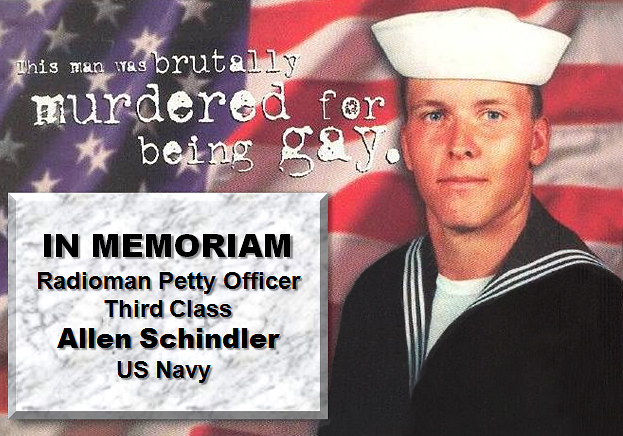
Each year, joined by his mother, the Chicago Chapter of American Veterans for Equal Rights (AVER) conducts a memorial at Schindler’s grave near the city.
“The old church bell will peal with joy
Hurrah! Hurrah!
To welcome home our darling boy,
Hurrah! Hurrah!
The village lads and lassies say
With roses they will strew the way,
And we’ll all feel gay
When Johnny comes marching home.”
Don't forget to share:















